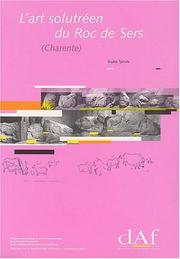| Listing 1 - 4 of 4 |
Sort by
|

ISSN: 0769010X ISBN: 2735108082 2735126390 Year: 2020 Volume: 91 Publisher: Paris : Éditions de la Maison des sciences de l’homme,
Abstract | Keywords | Export | Availability | Bookmark
 Loading...
Loading...Choose an application
- Reference Manager
- EndNote
- RefWorks (Direct export to RefWorks)
Gisement clé de l’art paléolithique, le site d’habitat solutréen du Roc de Sers et le dispositif pariétal sculpté qui te caractérise sont présentés selon une approche scientifique exigeante. Au-delà de la relation forme-support, qui trouvera son plein développement au Magdalénien, et de normes gestuelles issues d’une transmission contrôlée des procédés techniques de la sculpture, l’expression artistique et symbolique, replacée dans son contexte technoéconomique et socio-culturel, s’enrichit ici d’innovations originales ; constructions complexes, art du contour et maîtrise des ombres créent des effets visuels suggérant les volumes et une traduction de la perspective. Cette maîtrise de la troisième dimension, avancée considérable dans l’art pariétal, conjugue représentations figuratives, mais aussi composites, non conventionnelles, voire abstraites, reflets d’une société où s’affirme le concept de régionalisation. Of fundamental importance for the study of palaeolithic art, the Solutrean settlement site of Roc de Sers and the sculpted cave-wall art which typihes it are presented within a rigorous scientific framework Beyond the form-support relationship, developed to its fullest expression in the Magdalenian period, and the canon of gestures resulting from carefully controlled transmission of technical sculpting procedures, artistic and symbolic expression, seen from a techno-economic and sociocultural perspective, were enhanced by other inventive innovations Complex construction, use of contours and mastery of shadow work together to create Visual effects suggesting volume and perspective. The mastery of the third dimension, a considerable advance in the realm of cave-wall art, combines figurative art with unconventional, sometimes abstract composite figures, reflecting a society in which the concept of regionalism is gaining ground.
Solutrean culture --- Art, Prehistoric --- Solutréen --- Art préhistorique --- Charente (France) --- Antiquities --- Antiquités --- Solutréen --- Art préhistorique --- Antiquités --- Paleolithic period --- Prehistoric art --- Art, Primitive --- Charanta (France) --- Chérente (France) --- Angoumois (France) --- Antiquities. --- Solutrean culture. --- Prehistoric archaeology
Book
ISBN: 0860545938 Year: 1988 Volume: 462 Publisher: Oxford : BAR,
Abstract | Keywords | Export | Availability | Bookmark
 Loading...
Loading...Choose an application
- Reference Manager
- EndNote
- RefWorks (Direct export to RefWorks)
Prehistoric peoples --- Solutrean culture --- Homme préhistorique --- Solutréen --- Almería (Spain : Province) --- Ambrosio Cave (Spain) --- Almeria (Espagne : Province) --- Ambrosio, Grotte (Espagne) --- Antiquities --- Antiquités --- -Paleolithic period --- Almeria (Spain : Province) --- -Cueva Ambrosio (Spain) --- Cueva de Ambrosio (Spain) --- Cueva del Tesoro (Almería, Spain) --- Tesoro Cave (Almería, Spain) --- Spain --- -Ambrosio Cave (Spain) --- -Antiquities --- Homme préhistorique --- Solutréen --- Almería (Spain : Province) --- Antiquités --- Paleolithic period --- Cueva Ambrosio (Spain) --- Almería (Province) --- Granada (Spain : Reino) --- Antiquities.
Book
ISBN: 845054467X 9788450544671 Year: 1986 Volume: 148 Publisher: Madrid: Ministerio de cultura. Dirección general de bellas artes y archivos. Subdirección general de arqueología y etnología,
Abstract | Keywords | Export | Availability | Bookmark
 Loading...
Loading...Choose an application
- Reference Manager
- EndNote
- RefWorks (Direct export to RefWorks)
Solutrean culture --- Ambrosio Cave (Spain) --- Spain --- Antiquities --- 902 <460 CUEVA DE AMBROSIO> --- -Paleolithic period --- Archeologie--Spanje--CUEVA DE AMBROSIO --- Cueva Ambrosio (Spain) --- Cueva de Ambrosio (Spain) --- Cueva del Tesoro (Almería, Spain) --- Tesoro Cave (Almería, Spain) --- -Archeologie--Spanje--CUEVA DE AMBROSIO --- 902 <460 CUEVA DE AMBROSIO> Archeologie--Spanje--CUEVA DE AMBROSIO --- -902 <460 CUEVA DE AMBROSIO> Archeologie--Spanje--CUEVA DE AMBROSIO --- Stone implements --- Stone-cutting --- Solutréen --- Industrie lithique --- Tracéologie --- Pierre --- Taille --- Almería (Spain : Province) --- Ambrosio, Cueva de (Espagne) --- Antiquities. --- Paleolithic period --- Almería (Spain : Province) --- Almería (Province) --- Granada (Spain : Reino) --- Velez-Blanco (Almeria) --- Solutrean culture - Spain - Almería (Province) --- Spain - Antiquities --- Solutréen --- Tracéologie
Multi
ISSN: 01433067 ISBN: 9781407314709 140731470X Year: 2015 Volume: 2778 Publisher: Oxford : BAR,
Abstract | Keywords | Export | Availability | Bookmark
 Loading...
Loading...Choose an application
- Reference Manager
- EndNote
- RefWorks (Direct export to RefWorks)
Five basic Solutrean point types from the Iberian Peninsula are analysed at local, regional and Pan-Iberian scales in this book. The author reports new results concerning production process and object biography in relation to raw material procurement, technological strategies during production and use-life, site type and regional features. Significant regional differences between Northern and Southern Iberia are demonstrated, which go far beyond typological observations. Evidence indicates that different settlement and mobility patterns are responsible for these regional adaptations of technological innovations. The author successfully links point techno-morphology to humand land use. The book is a major resource for the study of Solutrean points, as well as for studies on projectile points in general. In addition, it serves as a guideline for how to approach the study of land use of palaeolithic hunter-gatherers on the base of lithic technology.
Excavations (Archaeology) --- Tools, Prehistoric --- Solutrean culture --- Prehistoric peoples --- Hunting and gathering societies --- Antiquities, Prehistoric --- Paleolithic period --- Fouilles (Archéologie) --- Outils préhistoriques --- Solutréen --- Homme préhistorique --- Chasseurs-cueilleurs --- Antiquités préhistoriques --- Paléolithique --- Iberian Peninsula --- Ibérique, Péninsule --- Antiquities. --- Antiquités --- Fouilles (Archéologie) --- Outils préhistoriques --- Solutréen --- Homme préhistorique --- Antiquités préhistoriques --- Paléolithique --- Ibérique, Péninsule --- Antiquités --- Periodicals --- Solutrean culture - Iberian Peninsula --- Excavations (Archaeology) - Iberian Peninsula --- Tools, Prehistoric - Iberian Peninsula --- Prehistoric peoples - Iberian Peninsula --- Hunting and gathering societies - Iberian Peninsula --- Antiquities, Prehistoric - Iberian Peninsula --- Paleolithic period - Iberian Peninsula --- Iberian Peninsula - Antiquities.
| Listing 1 - 4 of 4 |
Sort by
|

 Search
Search Feedback
Feedback About UniCat
About UniCat  Help
Help News
News